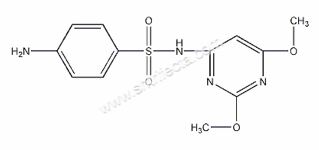Sulfadimethoxine CAS: 122-11-2
Information: Sulfadimethoxine is a white, almost tasteless and odorless compound. Chemically, it is N1-(2,6-dimethoxy-4-pyrimidinyl) sulfanilamide. Sulfadimethoxine/ormetoprim shares mechanisms of action and probably the bacterial spectrum of activity with trimethoprim/sulfa. Alone, sulfonamides are bacteriostatic agents, but in combination with either ormetoprim or trimethoprim, the potentiated sulfas are bactericidal. Potentiated sulfas sequentially inhibit enzymes in the folic acid pathway, thereby inhibiting bacterial thymidine synthesis. The sulfonamide blocks the conversion of para-aminobenzoic acid (PABA) to dihydrofolic acid (DFA) and ormetoprim blocks the conversion of DFA to tetrahydrofolic acid by inhibiting dihydrofolate reductase.
The potentiated sulfas have a fairly broad spectrum of activity. Gram positive bacteria that are generally susceptible include, most streptococci, many strains of staphylococcus, and Nocardia. Many gram negative organisms of the family Enterobacteriaceae are susceptible to the potentiated sulfas, but not Pseudomonas aeruginosa. Some protozoa (Pneumocystis carinii, Coccidia and Toxoplasma) are also inhibited by the combination. Potentiated sulfas reportedly have little activity against most anaerobes, but opinions on this vary.
Sulfadimethoxine has been demonstrated clinically or in the laboratory to be effective against a variety of organisms, such as streptococci, klebsiella, proteus, shigella, staphylococci, escherichia, and salmonella. These organisms have been demonstrated in respiratory, genitourinary, enteric, and soft tissue infections of dogs and cats.
The systemic sulfonamides which include sulfadimethoxine are bacteriostatic agents. Sulfonamides competitively inhibit bacterial synthesis of folic acid (pterolyglutamic acid) from para-aminobenzoic acid. Mammalian cells are capable of utilizing folic acid in the presence of sulfonamides. The tissue distribution of sulfadimethoxine, as with all sulfonamides, is a function of plasma levels, degree of plasma protein binding, and subsequent passive distribution in the tissues of the lipid-soluble unionized form. The relative amounts are determined by both its pKa and by the pH of each tissue. Therefore, levels tend to be higher in less acid tissue and body fluids or those diseased tissues having high concentrations of leucocytes.
Sulfadimethoxine is indicated for the treatment of a wide range of respiratory, genitourinary tract, enteric, and soft tissue infections. For example: tonsillitis, pustular dermatitis, pharyngitis, anal gland infections, bronchitis, abscesses, pneumonia, wound infections, cystitis, bacterial enteritis, nephritis, canine salmonellosis, metritis, bacterial enteritis associated with coccidiosis in dogs, pyometra when caused by streptococci, staphylococci, escherichia, salmonella, klebsiella, proteus or shigella organisms, sensitive to sulfadimethoxine.
Synonyms: 6-Sulfanilamido-2,4-dimethoxypyrimidine; Dinosol
Molecular Formula: C12H14N4O4S



